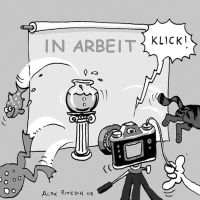Beige Norway Rat (Rattus norvegicus f. dom. 'Beige')
| Beige Norway Rat Rattus norvegicus f. dom. 'Beige' | |
|---|---|
| Name | Beige Norway Rat |
| Name Lat. | Rattus norvegicus f. dom. 'Beige' |
| Family | Murids |
| Family lat. | Muridae |
| Order | Rodents |
| Order lat. | Rodentia |
| Origin | Asia (breeding variety) |
| Climate | Temperate |
| Habitat | Savanna, steppe |
| Diet | Seeds, green fodder, insects |
| Behavior | Nocturnal; ♂ territorial |
| Keeping | Pair, group |
| Care Level | Easy |
| Life Span | 2-3 years |
| Protection | No |
| Metric Units | |
| Size | 18 cm |
| Temperature | Room temperature |
| Housing | 100 x 50 x 100 cm |
| US Units | |
| Size | 7.1" |
| Temperature | Room temperature |
| Housing | 40" x 20" x 40" |
Distribution and habitat
The beige colored rat is a breeding variety of the colored rat. This descends from the Norway rat (Rattus norvegicus), which reached Europe from Central Asia in the 9th century and largely displaced the domestic rat (Rattus rattus).
Cage size
The enclosure size should be at least L 100 x W 50 x H 100 cm, because they are very fond of movement. A rodentarium or terrarium is ideal and should be placed in a bright (no direct sunlight), quiet place. Terrariums need ventilation openings on the sides and must not be tightly closed at the top.
Maintenance
The enclosure should be variedly structured with roots and branches as well as sisal ropes, wooden ladders, hammocks etc. and offer hiding and shelter possibilities (houses made of wood or ceramics, tubes, clay caves etc.). Platforms connected with ramps expand the footprint. They need food and drinking containers (drinking bottles), a running wheel and nesting material (hay, pulp). Commercially available small animal litter or hemp litter is suitable as bedding. Nail material, such as untreated twigs and branches from fruit trees, and a rodent stone must always be available to wear down their teeth. They should be kept at room temperature and their natural day-night rhythm should be respected.
Diet
Their diet is mainly vegetarian, but they also need animal protein. The diet consists of a low-fat grain mixture, available in specialized stores as "rat food", supplemented with green food (root vegetables, wild herbs, zucchini, chicory, etc.). In addition, they need animal protein several times a week, such as lean curd cheese, a hard-boiled hen's egg, mild sliced cheese or cat food, and insect and egg food, especially during pregnancy and rearing of young. Live food (mealworm larvae, house crickets, etc.) is rarely accepted. Fruit should only be offered in small quantities. Drinking water must always be available in hanging bottles or in stable, open containers and, like food, must be offered fresh daily
A varied diet promotes health and prevents deficiency symptoms.
Behaviour and compatibility
They are very intelligent and social animals and should be kept in pairs or in a group, such as one (neutered) buck with several females or in female-only groups. Fierce territorial fights may occur between adult males. At the first sign of incompatibility, separate the animals immediately
Reproduction and breeding
The distance between the anus and the urethral outlet is greater in the male. In sexually mature males, testicles can be clearly seen.
The gestation period is 20-24 days. A litter usually consists of 8-12 young, which are born naked, blind and deaf. After about 2 weeks the eyes open. The young are suckled for 21 days and can then be separated from the mother. At the age of about 5 weeks they are sexually mature, they are ready for breeding after about 8 weeks. A female can have 5-6 litters per year. The life expectancy is 2-3 years.
Important
The Color Rat is bred today in many color varieties. The Beige Color Rat has a beige coat and light or dark red eyes
Variety is provided by changing furnishings and occasionally rearranging. Running wheels must be injury-proof, have a closed running surface and back wall, and a diameter of at least 30 cm
As escape animals, they need sufficient retreat and hiding places, so the enclosure should also be somewhat elevated and not placed on the floor.
They should not be grabbed or pulled by the tail, as it is very sensitive to pain and can easily break. The animals should only be grasped by hand from below and lifted up. Special attention should be paid to thorough hygiene and contamination should be removed regularly.
Further literature can be found in your pet store
References
Text: petdata; Image: Alex Rinesch
Source: BMEL (2014): Gutachten über Mindestanforderungen an die Haltung von Säugetieren; DIETZ, SCHNEIDER (2006): Meine Ratte zu Hause, bede Verlag;
- Gemäß § 21 Abs. 5 Tierschutzgesetz idgF
